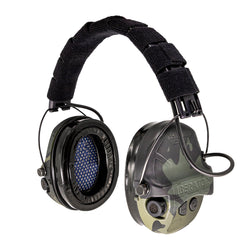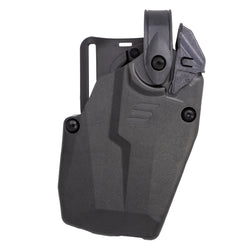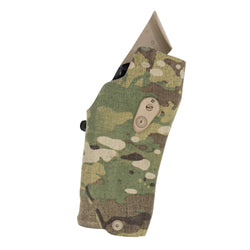When I lived in the Northeast, blizzards were the likely culprit for causing power outages. Here in North Carolina, we are more concerned with hurricanes, and depending on where you are in the country, there is a most-likely threat to your daily routine that will cause you to shelter in place and wait for normalcy to return. We’ve seen power outages, floods, and civil unrest cause havoc in just about every community across the country at one point or another.
This article is meant to serve as a primer or reminder of what you should keep on hand in a small container. A few items will go a long way when resources are limited and you will need to rely more on resourcefulness.

Water
A gallon of water weighs approximately eight pounds. On average, expect to set aside at least one gallon of water per person per 24 hour period. This will allow for hydration and basic sanitation.
The capacity of a 5 gallon bucket would not hold the required amount of water for two people for a 72 hour period. It makes sense to have separate water containers stored nearby.

What makes sense for a bucket prep is a water filter like the Grayl. It can be used to treat water coming from a municipal water source during a boil water advisory. In an extreme emergency, it can even be used to treat the water from the tank of a toilet.

You can decide if you want to treat the water from the bowl, but I’ll pass.
Food
Using the industry standard of 72 hours as the lifespan for most emergencies, it is safe to say the average American is not going to starve to death. Still, hunger is more of an annoyance in shorter durations than it is a threat to life. This reality leaves you plenty of options for food choices.
Commonly found energy bars, emergency lifeboat rations, MREs, and canned food can fit inside your bucket, but be careful of the space it occupies. If you decide to pack cans, make sure you have a way to open them.
If I don’t have to pack the food far, I would rather have food that doesn’t need to be reconstituted. I’m a major fan of Essential Provisions meals and have no issue rotating them out to keep them fresh since they are good enough to eat like a regular meal.

There may be more important resources to pack instead. Food will likely be more of an emotional resource in a short-term emergency than a necessity.
Illumination
There are many unknowns in an emergency, but there is a guarantee that day will turn to night. Sunlight will disappear, and darkness will envelope your surroundings.
Having adequate light is a concern, and you should make sure your bucket prep has a combination of lights for illuminating your surroundings, reaching out at distance for defense, and lasting through the night at a lower output for comfort. These lights should have spare batteries, and each person in your preparedness plan should have their own to avoid sharing lights.
Chemical light sticks make sense for disposable light that is easy to hand out to children, and a small area light that has a USB port can be used with a solar panel during the daytime to keep the charge at night.

Chemical Hand Warmers
Chemical hand warmers provide artificial warmth to the body. They are not limited to use on the hands and when placed against the kidneys, groin, and under the arm pits, they can keep you warm during the coldest hours of the night.
Compared to a burning flame, chemical hand warmers are much safer in confined spaces. Packing six per person per expected night will ensure there is enough heat for comfort. Paired with an emergency blanket that reflects body heat, this combination is an effective, compact solution to battle the cold. Add in a hat, socks, and gloves, and you’ll have even more warmth.
If you have children in the house, pack some candy and glow sticks in a Zip-loc bag with the chemical hand warmers, and you’ll have something to hand them that will make them feel important and loved.

Sanitation
An often overlooked element of disaster prep is sanitation. Our biological functions will not cease to exist when creature comforts disappear.
There are products like the Lugable Loo that create an emergency toilet from a 5-gallon bucket. This product comes in handy if you have to move from your secure location and have members in your party who want the comfort of using a standard toilet seat.
You can also use your standard toilet and manually flush it by adding water to the bowl if the municipal source is cut off. Wet wipes can be included in your bucket prep for wiping down all parts of the body. Hand sanitizer will help you prevent the spread of germs.

Emergency Candle
An open flame can be just as helpful as it can be harmful. If your emergency affects gas lines, you should avoid flames at all costs. However, if you experience a power outage, lighting a candle with multiple wicks or multiple candles is a risk worth taking.
Your candle can be used to heat food, making it more enjoyable. It can also be used to boil water, but the process will be considerably slower than a dedicated backpacking stove.

Utility
A handful of tools and resources will be multi-use in an emergency. Some of the most common items you may already have around the house can be consolidated into your bucket.
Endless problems can be solved with duct tape, and the tools on a Leatherman will become indispensable when others are not accessible or misplaced in the potential chaos of a given emergency. Little things like spare paracord, a strong claw hammer, and a wonder bar can hold things shut or pry them apart.
A dedicated toolbox is a great item to keep near your bucket prep, but if you can’t, some cherry-picked tools make sense.

Stored Nearby
The 72 hour bucket is a good place to start if you are just getting into setting aside some emergency preparation items. If anything, it provides a great exercise in critical thinking. If you only have so much space, you need to be wise with what you put inside the bucket and how much space each need should take up.
The wisdom in that exercise is realizing for a real emergency, you don’t want to limit yourself to the contents of a bucket. You may want to keep that bucket in a centrally located storage location with other items nearby and at the ready.
You may elect to store a separate first-aid kit with an additional module specifically for trauma. That first-aid kit should be large enough to support the medical needs of everyone in your household.
Another consideration for items stored nearby are home defense firearms. If your emergency results in a blackout and potential temporary lawlessness, it only makes sense to have firearms stored to address your personal security.
Should your emergency last longer than 72 hours, which is possible, you may want to have extra food and water for continued sustainment.

We never know when an emergency will happen, but we know they can and do happen. Rather than looking for needs, it’s better to have those solutions prepared in advance. Once you build up a bucket kit for your home, you can make one for the vehicle, workplace, or rally point at a trusted friend’s house.











